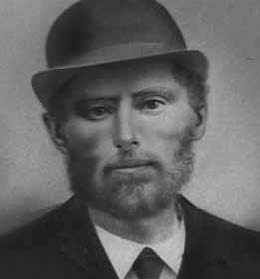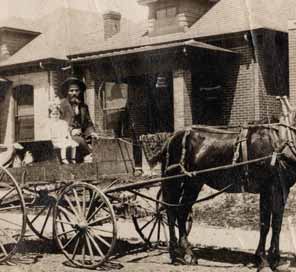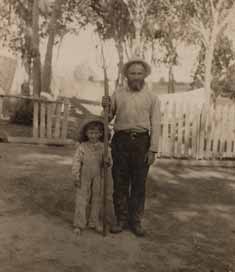Jews in the Wild West: Cotopaxi’s Orthodox Pioneers
The harsh, rocky desolate terrain of southern Colorado is an unlikely site for settlement of Yiddish-speaking Orthodox Jews. Yet, in 1882, devout immigrants from Tsarist Russia moved to Cotopaxi, Colorado, with the hopes of starting a Jewish agricultural colony. Here is their remarkable story of heroism and sacrifice.
In the spring of 1882, twenty-three-year-old Michel Shames, a recent immigrant from Russia, his young wife, Frieda Raisel, and their two small daughters boarded a train in New York City that would take them on a five-day journey to the arid lands of Colorado. The Shames family was joined by a dozen other Russian Jewish greenhorn families, including Michel’s father, three married sisters, and two younger siblings. Carrying only meager possessions, these newcomers brought with them rich Jewish traditions and hopes for better lives in America.

In 1882, twenty-three-year-old Michael Shames, his wife and children, along with other Orthodox immigrants from Russia, founded a Jewish agricultural colony in Cotopaxi. Photos courtesy of the Beck Archives, Special Collections, Penrose Library, University of Denver, unless indicated otherwise.
Shames’s dream and that of his relatives and friends was to found a Jewish agricultural colony and prove themselves as successful farmers. Indeed, the Cotopaxi Jewish colony, at its peak, grew to twenty-two families, with more than sixty men, women, and children, most of them related to each other.
Upon their arrival in the colony, the group, exhausted from their long journey, was greeted with much curiosity and some suspicion by local residents. Most of the immigrants spoke little English, although Michel’s brother-in-law, Philip Quiatkowsky, taught himself thousands of English words before setting out for America.
Among the idealistic farmers were former grain merchants, a carpenter, a tailor, a tavern keeper, and even a Hebrew teacher, all of whom now were prepared to take up plows and hoes. Which of them could have predicted they would have to contend with bitter harsh winters and scant supplies? Which of them could have predicted that they would have to light bonfires to discourage bears from attacking their flimsy cabins and making off with their precious kindling and limited food supplies? These were only a few of the many unpleasant surprises awaiting them in Cotopaxi.
In the 1880s, Cotopaxi was a small hamlet, with only 200 residents and a dozen businesses. The village was located at an elevation of 6,280 feet along the banks of the Arkansas River, about 150 miles west of Denver. In the 1870s, the area had begun to attract a few settlers and many mining prospectors.
Yudel (Ed) Grimes, a teenager at the time, was one of the first of the Jewish colonists at Cotopaxi. In a 1940 interview, Grimes recalled his experience: “[Cotopaxi] was the poorest place in the world for farming, poor lands, lots of big rocks and no water, and the few crops we were able to raise by a miracle were mostly eaten by cattle belonging to neighboring settlers.” The dim prospect of success was enough after the first year to launch seventeen-year-old Grimes on a 150-mile-walk to Denver, where he first worked for a dollar a day and saved enough money to bring eight family members to America.

Shul Baer Milstein was the patriach of the Cotopaxi colonists, although he never farmed there. He arrived in Denver in 1884, became a founder of Congregation Zera Abraham and built a successful cattle business.
The Cotopaxi Experiment
How did this unusual colony come about? In 1881 prominent local Cotopaxi Jewish businessman Emanuel Saltiel contacted the representatives of the German-Jewish-run Hebrew Immigrant Aid Society (HIAS) in New York and convinced them that Cotopaxi could be turned into a farming paradise for Jewish immigrants willing to work the land.
Between 1880 and 1890 alone, approximately 200,000 Jews emigrated from Eastern Europe to the United States, the majority of them from Russia and Poland. America’s established and highly acculturated German Jewish community viewed the newcomers who had fled their homelands due to persecution and grinding poverty with sympathy and a sense of obligation. At the same time, however, the German Jews feared that the new immigrants, with their sometimes-embarrassing “Old World” traditions, would promote anti-Semitism and threaten their middle-class status. One impetus, therefore, behind the German support of Jewish agricultural endeavors around the United States was to remove the Russian Jews from crowded urban areas on the East Coast, particularly from New York City, and disperse them around the country in an attempt to Americanize them more quickly.
Beginning in 1881, nearly twenty-five Jewish agricultural colonies were established in various locations around the United States by eager immigrants who had often been denied the right to own land in Europe. Unfortunately, few of these collective agrarian experiments made it.
Hebrew Immigrant Aid Society (HIAS) officials hoped that the Cotopaxi colonists would become self-supporting farmers, and they met with Jacob Milstein, who had arrived in America from Russia in 1878, to work out details for their support of the project. Jacob was the nephew of Shul Baer Milstein, a successful businessman and patriarch of the larger family back in Brest-Litovsk. Shul Baer realized there was little hope for Jews in Russia, due to the severe economic, religious, and social discrimination against Jews there, and Jacob had been sent ahead to scout out opportunities in America.
On paper, the site offered by Saltiel appeared to be a good match for the immigrants. Striking a deal with HIAS, Saltiel promised to procure the land for the settlers, build houses, and outfit the colonists. HIAS dispensed nearly $10,000 to set the Jewish pioneers up at Cotopaxi.

Jacob and Nettie Milstein were among the young eager colonists in Cotopaxi. They later homesteaded in Longmont and farmed in Broomfield, Colorado. Jacob is pictured here in his wagon with a granddaughter, circa 1900.
Shortly arriving in Cotopaxi, some of the men traveled by horse and wagon to inspect the site of their future homes. This was to be the first of their major disappointments. The finished homes and barns they had expected turned out to be eight rudely constructed cabins, about 16 by 20 feet or smaller, with no windows, chimneys, or furniture, and only four stoves for all twenty-two families! Three of the farms were located on a narrow strip of stony land adjacent to a stream, which was generally dry for most of the year.
Nettie and Jacob farmed near Broomfield, where they lived for years without running water or indoor plumbing for their family of nine children.
Of the 1,780 acres the Cotopaxi colonists were assigned, only a few hundred were fit for cultivation, and these required extensive irrigation. Bad weather, natural disasters, non-arable land, inexperience with high-altitude farming and meager supplies and farming implements plagued the colonists from the beginning. It seems the only crop they ever produced on the land was a poor harvest of potatoes. One colonist recalled that he reaped only fifteen bags of potatoes from the fourteen he had sown! The colonists also contended with food and fuel shortages. Desperate for money, several of the men turned to temporary jobs in Saltiel’s mines, toiling an entire day to earn $1.50. Others later earned three dollars a day working as track laborers with the Denver & Rio Grande Railroad and were pleased the company allowed them to work on Sundays instead of Shabbat.
Religious Life in the Colony
Although the agricultural aspect of the colony seemed destined to failure, the religious and community life of the colonists flourished. The gentile population of Cotopaxi offered the use of a newly constructed schoolhouse for Shabbat services for the Jewish colonists. Soon a cabin that would serve as a shul was designated and named B’nai Shalom, and the colonists devotedly made the long trek by foot on Shabbat and yomim tovim. One of their first requests of HIAS—before housing and farming implements—was a sefer Torah. The arrival of the Torah, dedicated on June 23, 1883, was greeted with joyous festivity. The New York Jewish Messenger described the ceremonies:
At 5:30 precisely the procession was formed as follows: First marched the elders of the colonists, each with a candle in his hand, then came a chuppah, the four poles carried by four single men, and later came the women and children. The procession then entered the Synagogue and several Psalms were sung, the Russians chanting those peculiar melodies which so deeply move the Jewish heart…
Two Passover Seders were conducted while the colonists resided in Cotopaxi, one led by the learned Hebrew teacher, David Grupitsky, who served as the chazzan and rabbi of the group. The colonists also requested and received kosher meat and matzah from Denver, which they supplemented with matzah they baked themselves using flour they obtained by walking twenty-six miles to the small town of Salida. The Denver Jewish community, less than 500 people at the time, provided whatever modest financial aid, food and clothing they could to assist their Cotopaxi brethren.
The challenges at Cotopaxi became insurmountable. By June 1884—nearly two years after the settlement was first founded—despite their heroic efforts, the colonists were forced to disband. Most moved to Denver, although a few pursued farming in Derby and Broomfield, Colorado and other areas in the American West.

Some of the early Jewish Cotopaxi colonists on the steps of the E.S. Hart store in Cotopaxi , circa 1882. Courtesy of the American Jewish Historical Society
Courage and Continuity
While the colony was not successful, it did help shape a group of Jewish leaders who would make significant contributions to Jewish life in the American West and perpetuate Jewish continuity in the region. The Cotopaxi experiment provided the colonists with experience interacting with their new neighbors, and valuable exposure to American cultural, civic and political life, easing the path of acculturation.
Shul Baer and his wife Miriam, and their younger children arrived in Denver in 1884, and built a successful cattle business.
The children started school in a one-room local schoolhouse several miles from the house, arriving for their lessons by foot or on horseback. The family sold their farmland to the Savory Mushroom Company during the Depression for the then-munificent sum of $18,000.

Jacob Milstein and granddaughter on his farm in Broomfield, Colorado, circa 1900.
Many of the Cotopaxi colonists who settled in Denver began working as peddlers, junk dealers, and small shopkeepers, and some later became successful business entrepreneurs and community leaders.
Grimes, the seventeen-year-old who walked all the way to Denver, became one of the founders of Denver’s West Side Orthodox Congregation Zera Abraham, incorporated in 1889, and still in existence today. He was also an organizer and first president in 1918 of the Moshev Zekanim Society, which evolved into Beth Israel Hospital and Home for the Aged. Grimes eventaully became a successful businessman, but he never forgot his immigrant origins, and he often offered newcomers a job or accompanied them to City Hall to obtain citizenship papers.
Ultimately the Cotopaxi saga was a success story. Had the Cotopaxi colonists remained in Russia, in the area now known as the Ukraine, many of their family members and their descendants would have certainly perished in the turbulent region, particularly later during the Holocaust.
Through their courage and perseverance these pioneers forged new and productive lives in America, forming the nucleus of what was to become Denver’s West Side Jewish community.
Jeanne Abrams is a professor at Penrose Library at the University of Denver and is the longtime director of the Beck Archives and the Rocky Mountain Jewish Historical Society, part of the University of Denver’s Center for Judaic Studies. She is the author of Jewish Women Pioneering the Frontier Trail: A History in the American West (New York, 2006) and Jewish Denver, 1859-1940 (South Carolina, 2007). She was active in NCSY and served as president of the Upper New York Har Sinai Region in 1967-68.
